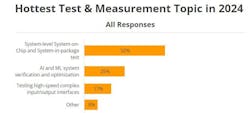The Expanding Role of Test in Advanced Electronic Systems Development
What you’ll learn:
- The state of the industry and issues facing the embedded electronics industry.
- The results of our survey on the hottest issues in test & measurement today.
A state of disruptive evolution in embedded electronics has been a global phenomenon over the last couple of decades, with society moving from black-and-white television and AM/FM radio to AI-empowered edge computing for cloud-based applications in a single person’s lifetime. This tumultuous and paradigm-changing migration to intelligent systems everywhere has changed society on every level, and there’s no indication that it will slow down in terms of pace or scope anytime soon.
These sophisticated devices, products, and services, along with their related hardware and software infrastructures, place a great deal of pressure on the electronic design engineering community to create, field, and maintain them in an effective and cost-efficient manner. One of the most important tools in the engineer’s bag to address these demands for optimal design is the ever-expanding capabilities in test & measurement systems and solutions.
The Importance of Test in Electronics
There’s no precision without feedback, and that goes double for advanced electronic systems. Issues like power and signal management have design issues measured to multiple decimal places today, with little or no room for error. Complicating the situation, the issues of performance and precision become even more critical when considering industry standards and regional regulatory requirements.
These myriad design and compliance issues can only be addressed by testing the components, boards, devices, and systems in every electronic product, from conception to its end of warranty in the field. The test & measurement systems must not only be as good as the electronics they’re evaluating, they also must be better, operating at a faster rate and with a higher precision than their targets.
The engineer needs the largest capture at the highest rate as fast as possible to get optimal results. The the lines on your ruler must be closer together than the lines on their ruler, otherwise you can’t make an accurate and useful measurement.
The need for test & measurement in advanced systems continues to evolve, with new fields of interest arriving on the scene and others leaving. The hot application spaces today aren’t the same as they were 20 years ago, and the solutions being created use the latest core technologies to address them. Recently, Microwaves & RF conducted a short survey on what the engineering community thought would be the hot test & measurement trends of the coming year.
2024 Test & Measurement Survey Results
The Quick Poll conducted by Microwaves & RF simply asked the readership what they thought would be the hottest test & measurement topic in 2024. The answers covered system-level test, AI and ML verification, high-speed I/O interfaces, ATE and manufacturing test, and cybersecurity. The responses were interesting and informative (see figure).
The answer “System-level System-on-Chip and System-in-package test” was the most popular response, reflecting the growing level of device integration in the industry. The increased implementation of SoC, SiP, microboard, and other highly integrated circuit topologies intensifies the system design and troubleshooting burden on the T&M industry to create tools precise and accurate enough to properly evaluate the busy data and power buses involved.
This is related to the ever-higher power densities in circuit topologies enabled by wide-bandgap semiconductors and advanced control software. Moreover, these advanced systems have to be tested for design optimization—the test tools involved must not only be fast and accurate, but also capable of handling high power peaks and transients. That challenge is compounded by the higher and higher switching speeds achieved by advanced power electronics in gallium-nitride (GaN)-based topologies.
The explosive growth of artificial-intelligence and machine-learning (AI/ML) systems and their adoption in more products and solutions demand proper verification and optimization to reach their application goals in an efficient and cost-effective manner. These test tools ironically will include their own AI/ML algorithms and protocols, which must also be verified and calibrated.
One of the bigger issues that’s often ignored is the trust gap between what’s generated by AI and how comfortable a person can feel using it. Proper validation and certification of AI-based solutions will go a long way toward market acceptance.
Testing high-speed complex I/O interfaces is related to the increasing level of integration and complexity in embedded systems, but it also involves the network and server infrastructure of cloud-based systems and their devices. These IoT solutions may be relatively simple at the device level, but they involve high-bandwidth data-heavy communication links to the internet via both wired and wireless technology. A complex system may have relatively simple nodes, but with a high level of network complexity.
This web of interconnectivity, from the board level to the cloud, puts added pressure on the test & measurement community—not only to create solutions that can evaluate an individual device’s performance in a busy signal environment, but also how that device can impact the environment it operates in. These test tools must be able to address issues from managing board parasitics and their impact on the power and data buses on the board to how a wireless device functions in a noisy and crowded RF ecosystem.
ATE and manufacturing test didn’t get enough answers to move the needle. It’s a reflection of the maturity in the space and the fact that the disruptions in the industry deal with sub-categories within this space and not the space itself. There’s a lot of action going on in ATE and manufacturing test, but the challenges are coming from the sectors mentioned earlier. This is also true when it comes to testing for cybersecurity compliance and immunity, as the recognition of the issues in that space comes more from adoption and awareness.
Conclusion
This year will be full of interesting technological developments, at both the scientific and applied engineering levels. Some of these developments will ramp up the challenges and opportunities in these trend areas. However, others may create new areas of interest on their own and possibly leapfrog and supersede existing issues we used to think were problems until this particular solution came along.
No matter the situation, though, and no matter what next big trend(s) unfold, they will have to be tested and evaluated for performance, compliance, safety, and functionality.
About the Author
Alix Paultre
Editor-at-Large, Microwaves & RF
Alix is Editor-at-Large for Microwaves & RF.
An Army veteran, Alix Paultre was a signals intelligence soldier on the East/West German border in the early ‘80s, and eventually wound up helping launch and run a publication on consumer electronics for the U.S. military stationed in Europe. Alix first began in this industry in 1998 at Electronic Products magazine, and since then has worked for a variety of publications, most recently as Editor-in-Chief of Power Systems Design.
Alix currently lives in Wiesbaden, Germany.


